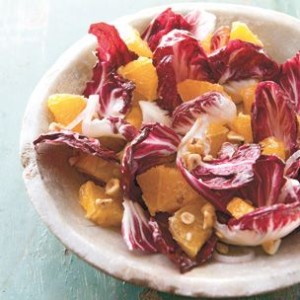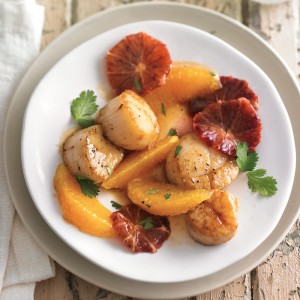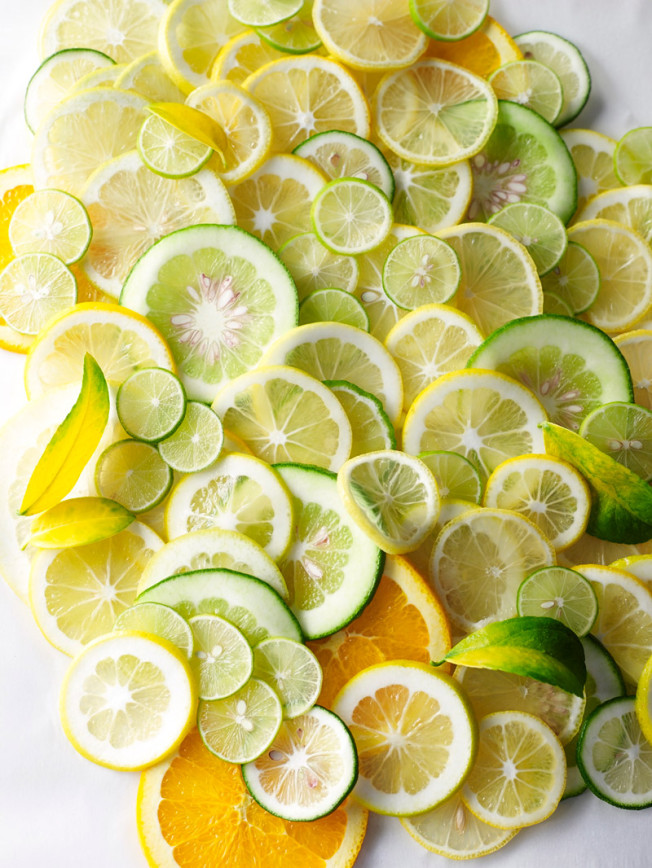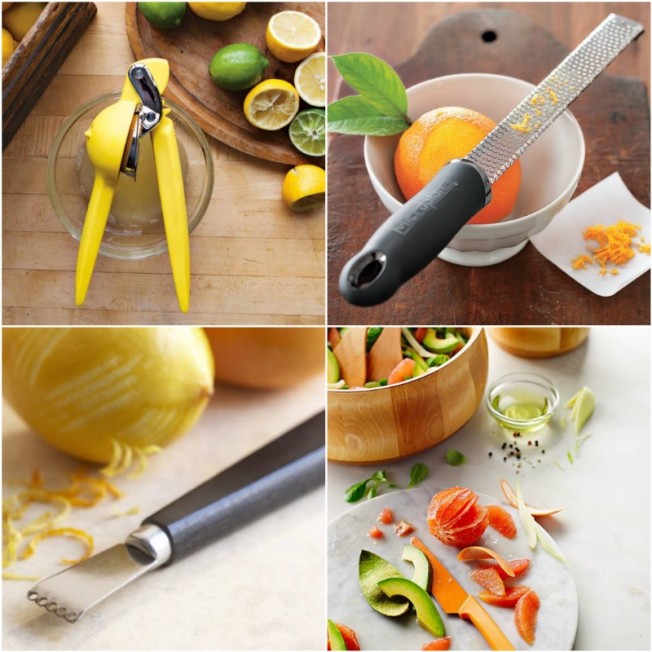All throughout January we’re bringing you 30 Days, 30 Ways to Good Health, a series of easy strategies for overall wellness (and because we love food, it’s focuses on the foods and cooking techniques to add into your life instead of what to take away.) Read on for our latest eat well strategy: brighten up with citrus.
Fresh, juicy citrus is a bright spot in the season’s harvest. Celebrate the bounty with oranges, grapefruits, lemons, limes and more — read on for our tips!
ORANGES can be sweet or bitter; the sweet ones are best for juicing or eating out of hand, while the bitter ones hold up well to sugar in marmalades and candies. Navel oranges, named for the indentation in the skin at the fruit’s stem end, are easy to peel and virtually seedless, with a sweet and juicy flesh. Smaller Valencia oranges have smooth skin and abundant juice, which is great for drinking and blending into vinaigrettes and sauces. Aromatic blood oranges have a reddish blush on the skin and intensely flavorful, deep red flesh and juice. Mandarin oranges are smaller and less acidic than other varieties, with loose peels and mild flesh.
LEMONS have tart juice and oil-rich zest that can flavor all kinds of dishes. Eureka lemons are the most common, known for their thick skins and sharply acidic juice that’s great for dressings. Meyer lemons, a cross between a lemon and a mandarin orange, are prized for their sweet, aromatic flesh and juice and thin, soft peel.
LIMES are smaller than lemons, with a thin green skin and a more acidic juice. Familiar grocery store varieties are Persian limes, while smaller, rounder Key limes grow in southern Florida; they have a thin skin and lots of seeds and were made famous by the classic Key lime pie.
GRAPEFRUITS are a cross between oranges and pomelos. They can be yellow or pink. The former have pale yellow skin, whitish flesh and a tart-sweet flavor; the latter, with an orange-red blush on the skin and pink flesh, are usually sweeter than yellow varieties.
TANGELOS are a cross between a tangerine and a pomelo or grapefruit. These sweet-tart fruits look like large oranges with knobs at their stem ends, and they can be used similar to mandarins.
POMELOS are ancestors of the grapefruit, with thick, bumpy skins and bittersweet, seedless flesh that ranges from yellow to pink to red. P
KUMQUATS look like elongated miniature oranges, and they are usually eaten whole; the sweetness of the skin balances the tartness of the flesh.
SELECTING & STORING
Choose fruits that feel firm and are heavy for their size, a sign of juiciness. Avoid ones with blemishes or soft spots. Most citrus fruits can be stored at room temperature for about a week or in the refrigerator for 3 to 4 weeks. They will be juicier and sweeter if brought to room temperature before serving.
PREPARING
Juicing citrus releases the tangy, flavorful juice inside, which can be very tart or very sweet, depending on the fruit. A squirt of lemon juice heightens and brightens a dish, offsetting rich foods and cleansing the palate. Citrus juice makes a great substitute for vinegar in vinaigrettes, and it also works well in sauces and marinades.
Zesting the fruits gives you bits of the aromatic peel, rich in essential oils. Citrus zest is a key ingredient in desserts, braises and stews. You can zest in thin strips to use as a garnish, or you can grate it into fine rasps. Just make sure to zest only the outermost part of the rind, as the pith (the white portion under the skin) can taste bitter.
Segmenting citrus is the best way to remove the fruit from the pith and membranes, so it’s ready to toss in salads and other dishes. Use a sharp knife to cut a thick slice off the top and the bottom of the fruit, exposing the pulp. Hold the fruit upright and slice off the peel in thick strips, cutting around the contours of the fruit. Hold the peeled fruit over a bowl. Using the knife, carefully cut between the fruit and membrane on either side of each segment to free it, letting it drop into the bowl with the juices. Discard any seeds. Here’s your toolkit:
- Chef’n Citrus Juicer for extracting every drop of juice from halved citrus fruits, using an inverted press
- Microplane Rasp Grater to quickly zest into tiny pieces
- Citrus Zester for creating tiny pith-free strips of citrus peel
- Kai Citrus Knife, with its serrated blade, to cut quickly through the tough rind of citrus fruits and segment them
See some of our favorite ways to use citrus — raw, cooked, baked and preserved.
 Crostini with Herbed Chèvre and Kumquats Crostini with Herbed Chèvre and KumquatsThis unexpected combination of soft goat cheese and kumquats is delightful; the slightly tangy goat cheese pairs wonderfully with the bright, juicy citrus fruit. |
 Radicchio, Orange and Hazelnut Salad Radicchio, Orange and Hazelnut SaladThe colors of this salad are dramatic: deep burgundy leaves, orange citrus, white shallot slices and toasty brown nuts. You can use any variety of orange—navels, blood oranges or rosy Cara Caras are all equally delicious. |
 Halibut with Grapefruit, Parsley and Fennel Halibut with Grapefruit, Parsley and FennelHalibut is firm and stays nice and juicy when panfried or roasted. Fennel is a natural choice for fish and when paired with citrus, gets even better. |
 Roasted Beef, Arugula and Tangerine Salad Roasted Beef, Arugula and Tangerine SaladHere, rich and savory roast beef pairs perfectly with sweet-tart tangerines and peppery arugula for a main course salad. |
 Pan-Seared Scallops with Sautéed Oranges Pan-Seared Scallops with Sautéed OrangesThis colorful winter dish showcases two types of oranges: the standard navel orange and the crimson blood orange, which make a refreshing counterpoint to seared sea scallops. |
 Meyer Lemon, Spinach and Goat Cheese Pizza Meyer Lemon, Spinach and Goat Cheese PizzaThin slices of Meyer lemon lend a pleasant tang to this meatless pizza. |
 Fusilli with Lemon Zest and Ricotta Fusilli with Lemon Zest and RicottaHere, the juice and zest from Meyer lemons are combined with ricotta cheese and cream to create a delicious meatless pasta sauce. |
 Ricotta with Blood Orange, Pistachio and Honey Ricotta with Blood Orange, Pistachio and HoneyThis simple dessert features creamy ricotta cheese with a few toppings of varied flavors and textures: crunchy pistachios, vibrant pomegranate seeds, flowery honey and, of course, juicy, berry-like blood oranges. |
 Triple Citrus-Ginger Quick Bread Triple Citrus-Ginger Quick BreadZest from three types of citrus fruit—orange lemon and lime—adds a refreshing note to this quick bread, while candied ginger lends a sweet undertone. |
 Meyer Lemon Tart Meyer Lemon TartMoravian cookies lend a subtle sweet spice to this bright lemony tart, which makes an impressive ending to a celebratory meal. Our recipe calls for a prepared lemon curd to streamline prep. |
 Coconut Cupcakes with Lime Curd Filling Coconut Cupcakes with Lime Curd FillingThese moist cakes are filled with a sweet surprise: tangy lime curd. A lime flavored glaze and a dusting of toasted coconut tops them off. |
 Mile-High Lemon Meringue Pie Mile-High Lemon Meringue PieIf you love billowy meringue, this is the pie for you. It is piled extra high above a perfectly tart-sweet, silky smooth lemon filling. |
 Blood Orange Marmalade Blood Orange MarmaladeThe sweet-tart juice and slightly bitter peel of blood oranges are ideal for marmalade. Use a mandoline, if possible, to slice the oranges thinly. |
 Meyer Lemon Jelly Meyer Lemon JellyThis simple jelly showcases the distinctive flavor of Meyer lemon. See the full recipe for a twist using fresh lemon verbena leaves. |
 Candied Grapefruit Peel Candied Grapefruit PeelThis old-fashioned sweet makes a great homemade gift. For a fancy touch, dip about two-thirds of each peel into melted bittersweet chocolate and place on wire racks until the chocolate sets. |
 Tangerine Curd Tangerine CurdTangerines and tangelos can be used in this creamy curd. Here, we add a few squeezes of lemon juice to give it some extra zing. |
 Kumquat-Orange Bellini Kumquat-Orange BelliniCitrus fruits shine in this refreshing cocktail created by Suzanne Goin, the award-winning chef/owner of four Southern California restaurants. For a nonalcoholic version, substitute sparkling water for the sparkling wine. |


